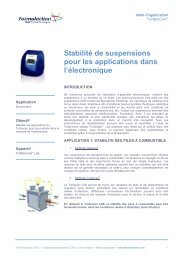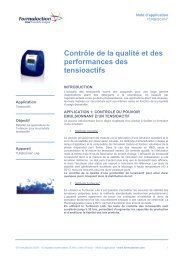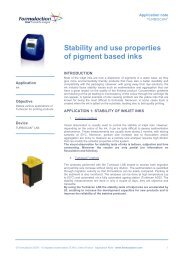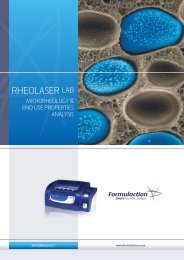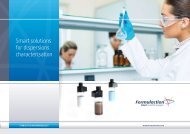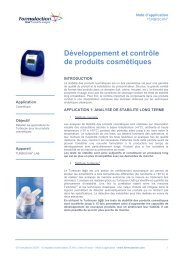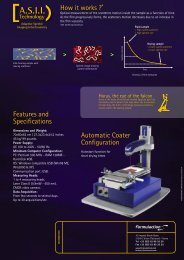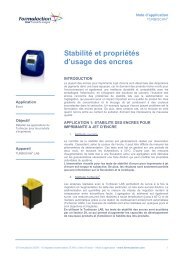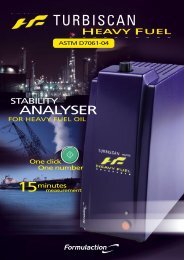Stability of petroleum oil - Formulaction
Stability of petroleum oil - Formulaction
Stability of petroleum oil - Formulaction
You also want an ePaper? Increase the reach of your titles
YUMPU automatically turns print PDFs into web optimized ePapers that Google loves.
Application<br />
Petroleum<br />
Objective<br />
Details various applications <strong>of</strong><br />
Turbiscan for <strong>petroleum</strong> products<br />
Device<br />
TURBISCAN ® LAB and<br />
TURBISCAN ® Classic<br />
<strong>Stability</strong> <strong>of</strong> <strong>petroleum</strong> <strong>oil</strong><br />
INTRODUCTION<br />
Application note<br />
TURBISCAN ®<br />
Crude <strong>oil</strong>s and heavy fuels are complex colloidal mixtures containing high added<br />
value products such as fuel but also many by-products (water, minerals,<br />
asphaltenes, etc.). These latter can cause various problems during the <strong>oil</strong><br />
transformation (aggregation, pipe blockages, emulsion formation, etc.). To overcome<br />
these technical issues, chemical additives are used. It is therefore interesting to<br />
have a technique that can help identify the most suitable additive, but also to<br />
measure accurately the stability <strong>of</strong> <strong>oil</strong> or emulsions.<br />
APPLICATION 1: EFFICIENCY OF ADDITIVES FOR DE-<br />
EMULSIFICATION<br />
Water is inevitably incorporated in the crude during the extraction. It can also be<br />
used to decrease the viscosity <strong>of</strong> the crude <strong>oil</strong> and to allow an easier pumping during<br />
extraction and transport. However, once the crude has been extracted, water is no<br />
longer required and need to be separated from the valuable hydrocarbon part. This<br />
process has to be quick but can be significantly delayed due to the presence <strong>of</strong><br />
surface-active compounds in the crude or various additives used during the<br />
extraction (e.g. asphaltenes, corrosion inhibitors).<br />
1. Common method<br />
Bottle tests are used to monitor the efficiency <strong>of</strong> additives on the de-emulsification <strong>of</strong><br />
crude <strong>oil</strong>. They are easy to perform but can take a long time waiting for the full<br />
separation and are subject to the judgement <strong>of</strong> the experimenter who measures the<br />
thickness <strong>of</strong> the phases and in some cases their relative opacity.<br />
Bottle tests are a tedious and subjective exercise that is time consuming.<br />
2. Turbiscan ® method<br />
The Turbiscan ® enables to replace bottle tests efficiently with its scanning device<br />
and its two detectors in transmission and backscattering. Detection <strong>of</strong> phase<br />
separation is therefore much quicker and objective than visual observation. The<br />
thermoregulation (up to 60°C) can be used to accelerate the phenomenon even<br />
more. Moreover, the opacity or transparency <strong>of</strong> the phases can be quantified<br />
optically and not left to human appreciation. Different samples can be easily<br />
compared via kinetics <strong>of</strong> phase separation.<br />
The Turbiscan ® enables to measure the efficiency <strong>of</strong> additives used for deemulsification<br />
as it sees instabilities much more rapidly and accurately than<br />
the eye. This analysis is objective, enabling to compare samples easily.<br />
© <strong>Formulaction</strong> 2009 - 10 impasse borde basse 31240 L'Union France - Application Note - www.formulaction.com 1
Application note<br />
TURBISCAN ®<br />
APPLICATION 2: EFFICIENCY OF DISPERSANTS FOR<br />
ASPHALTENES<br />
Asphaltenes are causing major loss <strong>of</strong> money in the extraction process as they can<br />
block pipes or even the entire well when aggregating and settling. Moreover, the<br />
problem is also becoming more and more important in refineries as crude <strong>oil</strong>s are<br />
getting less stable regarding asphaltenes. In addition, their complex and variable<br />
nature makes them difficult to control and to model theoretically.<br />
1. Common method:<br />
Few techniques enable to measure the efficiency <strong>of</strong> dispersant in preventing<br />
asphaltenes to settle and block pumps or pipes during crude <strong>oil</strong> extraction. Among<br />
them, one can find the bottle test previously mentioned, the spot test and various<br />
theoretical models trying to explain the phenomenon, but none <strong>of</strong> them is totally<br />
satisfying because they are not reliable enough and are too time consuming.<br />
2. Turbiscan ® method:<br />
The Turbiscan ® can measure the dispersion state (asphaltenes well dispersed,<br />
flocculated or settled in crude <strong>oil</strong> or heavy fuel) when visual observation is tricky due<br />
to the darkness <strong>of</strong> the sample. Kinetics <strong>of</strong> flocculation and sedimentation can be<br />
drawn to compare samples easily and objectively. Velocity <strong>of</strong> migration can be<br />
computed.<br />
Using the Turbiscan ® , the efficiency <strong>of</strong> dispersant on asphaltenes stability can<br />
be monitored objectively in less than 30 minutes. General information on the<br />
stability <strong>of</strong> crude <strong>oil</strong> and heavy fuel stability can also be obtained.<br />
CONCLUSION<br />
These tests concern R&D labs that develop new molecules for improving various<br />
processes <strong>of</strong> <strong>oil</strong> extraction and production, but also salesmen and services<br />
companies for showing the efficiency <strong>of</strong> their additives on the field (portable<br />
instrument). Finally, <strong>oil</strong> companies can use them in the field or in refineries in order<br />
to check their <strong>oil</strong> (stability <strong>of</strong> crude <strong>oil</strong> or heavy fuel, compatibility <strong>of</strong> crude, etc.).<br />
They can also be applied to any similar applications, such as sedimentation <strong>of</strong><br />
minerals (calcium or barium carbonate, etc.).<br />
© <strong>Formulaction</strong> 2009 - 10 impasse borde basse 31240 L'Union France - Application Note - www.formulaction.com 2



